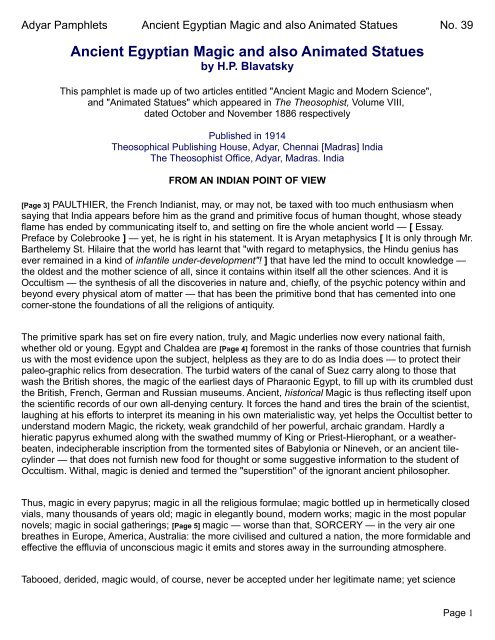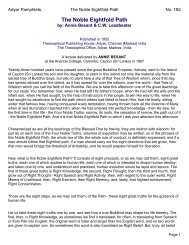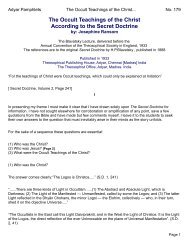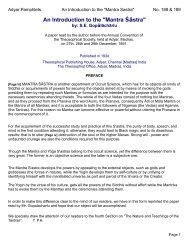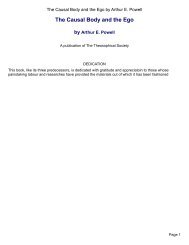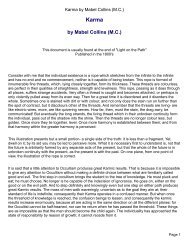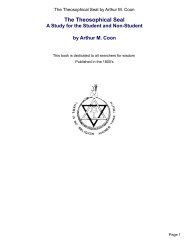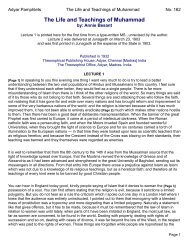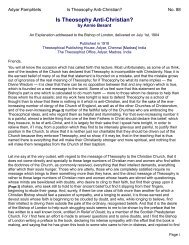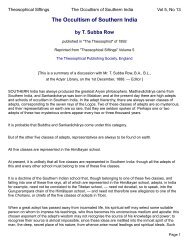Ancient Egyptian Magic and also Animated Statues
Ancient Egyptian Magic and also Animated Statues
Ancient Egyptian Magic and also Animated Statues
You also want an ePaper? Increase the reach of your titles
YUMPU automatically turns print PDFs into web optimized ePapers that Google loves.
Adyar Pamphlets <strong>Ancient</strong> <strong>Egyptian</strong> <strong>Magic</strong> <strong>and</strong> <strong>also</strong> <strong>Animated</strong> <strong>Statues</strong> No. 39<strong>Ancient</strong> <strong>Egyptian</strong> <strong>Magic</strong> <strong>and</strong> <strong>also</strong> <strong>Animated</strong> <strong>Statues</strong>by H.P. BlavatskyThis pamphlet is made up of two articles entitled "<strong>Ancient</strong> <strong>Magic</strong> <strong>and</strong> Modern Science",<strong>and</strong> "<strong>Animated</strong> <strong>Statues</strong>" which appeared in The Theosophist, Volume VIII,dated October <strong>and</strong> November 1886 respectivelyPublished in 1914Theosophical Publishing House, Adyar, Chennai [Madras] IndiaThe Theosophist Office, Adyar, Madras. IndiaFROM AN INDIAN POINT OF VIEW[Page 3] PAULTHIER, the French Indianist, may, or may not, be taxed with too much enthusiasm whensaying that India appears before him as the gr<strong>and</strong> <strong>and</strong> primitive focus of human thought, whose steadyflame has ended by communicating itself to, <strong>and</strong> setting on fire the whole ancient world — [ Essay.Preface by Colebrooke ] — yet, he is right in his statement. It is Aryan metaphysics [ It is only through Mr.Barthelemy St. Hilaire that the world has learnt that "with regard to metaphysics, the Hindu genius hasever remained in a kind of infantile under-development"! ] that have led the mind to occult knowledge —the oldest <strong>and</strong> the mother science of all, since it contains within itself all the other sciences. And it isOccultism — the synthesis of all the discoveries in nature <strong>and</strong>, chiefly, of the psychic potency within <strong>and</strong>beyond every physical atom of matter — that has been the primitive bond that has cemented into onecorner-stone the foundations of all the religions of antiquity.The primitive spark has set on fire every nation, truly, <strong>and</strong> <strong>Magic</strong> underlies now every national faith,whether old or young. Egypt <strong>and</strong> Chaldea are [Page 4] foremost in the ranks of those countries that furnishus with the most evidence upon the subject, helpless as they are to do as India does — to protect theirpaleo-graphic relics from desecration. The turbid waters of the canal of Suez carry along to those thatwash the British shores, the magic of the earliest days of Pharaonic Egypt, to fill up with its crumbled dustthe British, French, German <strong>and</strong> Russian museums. <strong>Ancient</strong>, historical <strong>Magic</strong> is thus reflecting itself uponthe scientific records of our own all-denying century. It forces the h<strong>and</strong> <strong>and</strong> tires the brain of the scientist,laughing at his efforts to interpret its meaning in his own materialistic way, yet helps the Occultist better tounderst<strong>and</strong> modern <strong>Magic</strong>, the rickety, weak gr<strong>and</strong>child of her powerful, archaic gr<strong>and</strong>am. Hardly ahieratic papyrus exhumed along with the swathed mummy of King or Priest-Hierophant, or a weatherbeaten,indecipherable inscription from the tormented sites of Babylonia or Nineveh, or an ancient tilecylinder— that does not furnish new food for thought or some suggestive information to the student ofOccultism. Withal, magic is denied <strong>and</strong> termed the "superstition" of the ignorant ancient philosopher.Thus, magic in every papyrus; magic in all the religious formulae; magic bottled up in hermetically closedvials, many thous<strong>and</strong>s of years old; magic in elegantly bound, modern works; magic in the most popularnovels; magic in social gatherings; [Page 5] magic — worse than that, SORCERY — in the very air onebreathes in Europe, America, Australia: the more civilised <strong>and</strong> cultured a nation, the more formidable <strong>and</strong>effective the effluvia of unconscious magic it emits <strong>and</strong> stores away in the surrounding atmosphere.Tabooed, derided, magic would, of course, never be accepted under her legitimate name; yet sciencePage 1
Adyar Pamphlets <strong>Ancient</strong> <strong>Egyptian</strong> <strong>Magic</strong> <strong>and</strong> <strong>also</strong> <strong>Animated</strong> <strong>Statues</strong> No. 39has begun dealing with that ostracised science under modern masks, <strong>and</strong> very considerably. But what isin a name? Because a wolf is scientifically defined as an animal of the genus canis, does it make of hima dog? Men of science may prefer to call the magic inquired into by Porphyry <strong>and</strong> explained byIamblichus hysterical hypnosis, but that does not make it the less magic. The result <strong>and</strong> outcome ofprimitive Revelation to the earlier races by their "Divine Dynasties" the king-instructors, became innateknowledge in the Fourth race, that of the Atlanteans; <strong>and</strong> that knowledge is now called in its rare cases of"abnormal" genuine manifestations mediumship. The secret history of the world preserved only in faraway,secure retreats, would alone, if told unreservedly, inform the present generations of the powersthat lie latent, <strong>and</strong> to most unknown, in man <strong>and</strong> nature. It was the fearful misuse of magic by theAtlanteans, that let their race to utter destruction, <strong>and</strong> — to oblivion. The tale of their sorcery <strong>and</strong> wickedenchantments has reached us, through classical writers, in fragmentary bits, as legends <strong>and</strong> childish[Page 6] fairy-tales, <strong>and</strong> as fathered on smaller nations. Thence the scorn for necromancy, goëtic magic,<strong>and</strong> theurgy. The "witches" of Thessaly are not less laughed at in our day than the modern medium or thecredulous Theosophist. This is again due to sorcery, <strong>and</strong> one should never lack the moral courage torepeat the term; for it is the fatally abused magic that forced the adepts, "the Sons of Light", to bury itdeep, after its sinful votaries had themselves found a watery grave at the bottom of the ocean; thusplacing it beyond the reach of the profane of the race that succeeded to the Atlanteans. It is, then, tosorcery that the world is indebted for its present ignorance about it. But who or what class in Europe orAmerica, will believe the report? With one exception, none; <strong>and</strong> that exception is found in the RomanCatholics <strong>and</strong> their clergy; but even they, while bound by their religious dogmas to credit its existence,attribute to it a satanic origin. It is this theory which, no doubt, has to this day prevented magic from beingdealt with scientifically.Still, nolens volens, science has to take it in h<strong>and</strong>. Archaeology in its most interesting department —Egyptology <strong>and</strong> Assyriology — is fatally wedded to it, do what it may. For magic is so mixed up with theworld's history that, if the latter is ever to be written at all in its completeness, giving the truth <strong>and</strong> nothingbut the truth, there seems to be no help for it. If Archaeology counts still upon discoveries <strong>and</strong> reports[Page 7] upon hieratic writings that will be free from the hateful subject, then HISTORY will never bewritten, we fear.One sympathises profoundly with, <strong>and</strong> can well imagine, the embarrassing position of the varioussavants <strong>and</strong> "F.R.S.'" of Academicians <strong>and</strong> Orientalists. Forced to decipher, translate <strong>and</strong> interpret oldmouldy papyri, inscriptions on steles <strong>and</strong> Babylonia rhombs, they find themselves at every moment faceto face with MAGIC! Votive offerings, carvings, hieroglyphics, incantations — the whole paraphernalia ofthat hateful "superstition" — state them in the eyes, dem<strong>and</strong> their attention, fill them with the mostdisagreeable perplexity. Only think what must be their feelings in the following case in h<strong>and</strong>. An evidentlyprecious papyrus is exhumed. It is the post-mortem passport furnished to the osirified soul [ The readerneed not be told that every soul newly-born into its cycle of 8,000 years after the death of the body itanimated, became in Egypt, an "Osiris", was osirified, viz., the personality became reduced to its higherprinciples, a spirit. ] of a just translated Prince or even Pharaoh, written in red <strong>and</strong> black characters by alearned <strong>and</strong> famous scribe, say of the Fourth Dynasty, under the supervision of an <strong>Egyptian</strong> Hierophant— a class considered in all the ages <strong>and</strong> held by posterity as the most learned of the learned, among theancient sages <strong>and</strong> philosophers. The statement therein were written at the solemn hours of the death<strong>and</strong> burial of a King Hierophant, of a Pharaoh <strong>and</strong> ruler. The purpose of the paper is the introduction ofthe "soul" to [Page 8] the awful region of Amenti, before its judges, there where a lie is said to outweighevery other crime The Orientalist carries away the papyrus <strong>and</strong> devotes to its interpretation days,perhaps weeks, of labour, only to find in it the following statement: "In the thirteenth year <strong>and</strong> the secondPage 2
Adyar Pamphlets <strong>Ancient</strong> <strong>Egyptian</strong> <strong>Magic</strong> <strong>and</strong> <strong>also</strong> <strong>Animated</strong> <strong>Statues</strong> No. 39month of Schomoo in the twenty-eight day of the same, we, the first High-priest of Ammon, the king ofthe gods, Penotman, the son of the delegate (or substitute) [ Substitute" was the name given to the fatherof the "Son" adopted by the High-priest Hierophant; a class of these remaining unmarried, <strong>and</strong> adopting"sons" for purposes of transmission of power <strong>and</strong> succession ] for the High-priest Pionki-moan, <strong>and</strong> thescribe of the temple of Sosser-sookhons <strong>and</strong> of the Necropolis Bootegamonmoo, began to dress the latePrince Oozirmari Pionokha, etc., etc., preparing him for eternity. When ready, the mummy was pleased toarise <strong>and</strong> thank his servants, as <strong>also</strong> to accept a cover worked for him by the h<strong>and</strong> of the "lady singer",Nefrelit Nimutha, gone into eternity the year so <strong>and</strong> so -" some hundred years before!" The whole inhieroglyphics.This may be mistaken reading. There are dozens of papyri, though, well authenticated <strong>and</strong> recordingmore curious readings <strong>and</strong> narratives than that corroborated in this, by Sanchoniaton <strong>and</strong> Manetho, byHerodotus <strong>and</strong> Plato, Syncellus <strong>and</strong> dozens of other writers <strong>and</strong> philosophers, who mention the subject.Those papyri note down very often, as seriously as any historical fact needing no special corroboration,[Page 9] whole dynasties of Kings' — manes, viz., of phantoms <strong>and</strong> ghosts. The same is found in thehistories of other nations.All claim for their first <strong>and</strong> earliest dynasties [ The Secret Doctrine teaches that those dynasties werecomposed of divine beings, "the ethereal images of human creatures", in reality "gods", in their luminousastral bodies; the Sishta of preceding manvantaras ] of rulers <strong>and</strong> kings, what the Greeks called Manes<strong>and</strong> the <strong>Egyptian</strong>s Ourvagan, "gods", etc.. Rossellius has tried to interpret the puzzling statement but invain. "The word manes meaning urvagan", he says, "<strong>and</strong> that term in its literal sense signifying exteriorimage, we may suppose, if it were possible to bring down that dynasty within some historical period —that the word referred to some form of theocratic governments represented by the images of the gods<strong>and</strong> priests"!! [ Rossellius (Volume I Storia degli Monumenti dell Egitto, page 8). He adds that Manetho<strong>and</strong> the old Chronicles agree in translating the word manes by nékues. In the Chronicles of EusebiusPamphilius, discovered at Milan <strong>and</strong> annotated by Cardinal Mai, the word nékues is <strong>also</strong> translatedurvagan, "the exterior shadow" or ethereal image of men"; in short, the astral body.]A dynasty of, to all appearance, living, at all events acting <strong>and</strong> ruling, kings turning out to have beensimply mannikins <strong>and</strong> images, would require, to be accepted, a far wider stretch of modern credulity thaneven "kings' phantoms".Were these Hierophants <strong>and</strong> Scribes, Pharaohs <strong>and</strong> King-Initiates all fools or frauds, confederates <strong>and</strong>liars, to have either believed themselves or tried to make other people believe in such cock-<strong>and</strong>-bullstories, if there were no truth at the foundation? And that for [Page 10] a long series of millenniums, fromthe first to the last Dynasty?Of the divine Dynasty of Manes, the test of the Secret Doctrine will treat more fully; but a few such featsmay be recorded from genuine papyri <strong>and</strong> the discoveries of archaeology. The Orientalists have found aplank of salvation: though forced to publish the contents of some famous papyri, they now call themRomances of the days of Pharaoh so-<strong>and</strong>-so. The device is ingenious, if not absolutely honest. Theliterary Sadducees may fairly rejoice.Page 3
Adyar Pamphlets <strong>Ancient</strong> <strong>Egyptian</strong> <strong>Magic</strong> <strong>and</strong> <strong>also</strong> <strong>Animated</strong> <strong>Statues</strong> No. 39One of such is the so-called "Lepsius Papyrus" of the Berlin Museum, now purchased by the latter fromthe heirs of Richard Lepsius. It is written in hieratic characters in the archaic <strong>Egyptian</strong> (old Coptic)tongue, <strong>and</strong> is considered one of the most important archaeological discoveries of our age, inasmuch asit furnishes dates for comparison, <strong>and</strong> rectifies several mistakes in the order of dynastical successions.Unfortunately its most important fragments are missing. The learned Egyptologists who had the greatestdifficulty in deciphering it have concluded that it was "an historical romance of the sixteenth century B.C.,[ Supposititiously — during the eighteenth Dynasty of Kings, agreeably to Manetho's SynchronisticTables, disfigured out of recognition by the able Eusebius, the too clever Bishop of Caesarea. ] datingback to events that took place during the reign of Pharaoh Cheops, the supposed builder of the pyramidof that name, who [Page 11] flourished in the twenty-sixth (?) century before our era". It shows <strong>Egyptian</strong> life<strong>and</strong> the state of society at the Court of that great Pharaoh, nearly nine hundred years before the littleunpleasantness between Joseph <strong>and</strong> Mrs. Potiphar.The first scene opens with King Cheops on his throne, surrounded by his sons, whom he comm<strong>and</strong>s toentertain him with narratives about hoary antiquity <strong>and</strong> the miraculous powers exercised by thecelebrated sages <strong>and</strong> magicians at the Court of his predecessor. Prince Chefren than tells his audiencehow a magus during the epoch of Pharaoh Nebkha fabricated a crocodile out of wax <strong>and</strong> endowed himwith life <strong>and</strong> obedience. Having been placed by a husb<strong>and</strong> in the room of his faithless spouse, thecrocodile snapped at both the wife <strong>and</strong> her lover, <strong>and</strong> seizing them carried them both into the sea.Another prince told a story of his gr<strong>and</strong>father, the parent of Cheops, Pharaoh Senefru. Feeling seedy, hecomm<strong>and</strong>ed a magician into his presence, who advised him as a remedy the spectacle of twentybeautiful maidens of the Court sporting in a boat on the lake near by. The maidens obeyed <strong>and</strong> the hearof the old despot was "refreshed". But suddenly one of the ladies screamed <strong>and</strong> began to weep aloud.She had dropped into the water, one hundred <strong>and</strong> twenty feet deep in that spot, a rich necklace. Then amagician pronounced a formula, called the genii of the air <strong>and</strong> water to his help, <strong>and</strong> plunging his h<strong>and</strong>into the [Page 12] waves brought back with it the necklace. The pharaoh was greatly struck with the feat.He looked no more at the twenty beauties, "divested of their clothes, covered with nets, <strong>and</strong> with twentyoars made of ebony <strong>and</strong> gold"; but comm<strong>and</strong>ed that sacrifices should be made to the manes of thosetwo magicians when they died. To this Prince Gardadathu remarked that the highest among suchmagicians never die, <strong>and</strong> one of them lived to that day, more than a centenarian, at the town of Deyd-Snefroo; that his name was Deddy; <strong>and</strong> that he had the miraculous power of reuniting cut-off heads totheir bodies <strong>and</strong> recalling the whole to life, as <strong>also</strong> full authority <strong>and</strong> sway over the lions of the desert. He,Deddy, knew likewise where to procure the needed expensive materials for the temple of the god Thoth(the wisdom deity), which edifice Pharaoh Cheops was anxious to raise near his great pyramid. Uponhearing this, the mighty King Cheops expressed a desire to see the old sage at his Court! Thereupon thePrince Gardadathu started on his journey, <strong>and</strong> brought back with him the great magician.After long greetings <strong>and</strong> mutual compliments <strong>and</strong> obeisance, according to the papyrus, a longconversation ensued between the Pharaoh <strong>and</strong> the sage, which goes on briefly thus:"I am told, oh sage, that thou art able to reunite heads severed from their bodies to that latter.""I can do so, great King", answered Deddy. [Page 13]"Let a criminal be brought here, without delay", quoth the Pharaoh."Great Kind, my power does not extent to men. I can resurrect only animals", remarked the sage.Page 4
Adyar Pamphlets <strong>Ancient</strong> <strong>Egyptian</strong> <strong>Magic</strong> <strong>and</strong> <strong>also</strong> <strong>Animated</strong> <strong>Statues</strong> No. 39A goose was then brought, its head cut off <strong>and</strong> placed in the east corner of the hall, <strong>and</strong> its body at thewestern side. Deddy extended his arm in the two directions in turn <strong>and</strong> muttered a magic formula.Forthwith the body of the bird arose <strong>and</strong> walked to the center of the hall, <strong>and</strong> the head rolled up to meetit. Then the head jumped on the bleeding neck; the two were reunited; <strong>and</strong> the goose began to walkabout, none the worse for the operation of beheading.The same wonderful feat was repeated by Deddy upon canaries <strong>and</strong> a bull. After which the Pharaohdesired to be informed with regard to the projected temple of Thoth.The sage-magician knew all about the old remains of the temple, hidden in a certain house a Heliopolis:but he had no right to reveal it to the king. The revelation had to come from the eldest of the three tripletsof Rad-Dedtoo. "The latter is the wife of the priest of the Sun, at the city of Saheboo. She will conceivethe triplet-sons from the sun-god, <strong>and</strong> these children will play an important part in the history of the l<strong>and</strong>of Khemi (Egypt), inasmuch as they will be called to rule it. The eldest, before he becomes a Pharaoh,will be High-priest of the Sun at the city of Heliopolis. [Page 14]"Upon hearing this, Pharaoh Cheops rent his clothes in grief: his dynasty would thus be overthrown bythe son of the deity to whom he was actually raising a temple!"Here the papyrus is torn; <strong>and</strong> a large portion of it being missing, posterity is denied the possibility oflearning what Pharaoh Cheops undertook in this emergency.The fragment that follows apprises us of that which is evidently the chief subject of the archaic record —the birth of the three sons of the sun-god. As soon as Rad-Dedtoo felt the pangs of childbirth, the greatsun-god called the goddesses Isis, Nephthys, Mesehentoo, <strong>and</strong> Hekhtoo, <strong>and</strong> sent them to help thepriestess, saying: "She is in labour with my three sons who will, one day, be the rulers of this l<strong>and</strong>. Helpher, <strong>and</strong> they will raise temples for you, will make innumerable libations of wine <strong>and</strong> sacrifices". Thegoddesses did as they were asked, <strong>and</strong> three boys, each one yard long <strong>and</strong> with very long arms, [ Longarms in Egypt meant as now in India, a sign of mahãmãtship or adeptship. ] were born. Isis gave themtheir names <strong>and</strong> Nephthys blessed them, while the two other goddesses confirmed on them their gloriousfuture. The three young men became eventually kings of the Fifth Dynasty, their names being Ouserkath,Sagoorey <strong>and</strong> Kakäy. After the goddesses had returned to their celestial mansions some great miraclesoccurred. The corn [Page 15] given the mother goddesses returned of itself into the corn-bin in anouthouse of the High-priest, <strong>and</strong> the servants reported that voices of invisibles were singing in it thehymns sung at the birth of hereditary princes, <strong>and</strong> the sounds of music <strong>and</strong> dances belonging to that ritewere distinctly heard. This phenomenon endangered, later on, the lives of the future kings — the triplets.A female slave having been punished once by the High-priestess, the former ran away from the house,<strong>and</strong> spoke thus to the assembled crowds: " How dare she punish me, that woman who gave birth to threekings? I will go <strong>and</strong> notify it to Pharaoh Cheops, our lord."At this interesting place the papyrus is again torn; <strong>and</strong> the reader left once more in ignorance of whatPage 5
Adyar Pamphlets <strong>Ancient</strong> <strong>Egyptian</strong> <strong>Magic</strong> <strong>and</strong> <strong>also</strong> <strong>Animated</strong> <strong>Statues</strong> No. 39resulted from the denunciation, <strong>and</strong> how the three boy-pretenders avoided the persecution of theparamount ruler. [ This is the more to be regretted — says the translator of the papyrus — that"legendary details, notwithst<strong>and</strong>ing the contents of the Lepsius papyrus are evidently based upon themost ancient traditions; <strong>and</strong> as a a matter of fact emanate from eye-witnesses <strong>and</strong> first-h<strong>and</strong> evidence".The data in the papyrus are absolutely coincident with facts known, <strong>and</strong> agree with the discoveries madeby Egyptology <strong>and</strong> the undeniable information obtained concerning the history <strong>and</strong> far-away events ofthat "l<strong>and</strong> of mystery <strong>and</strong> riddle", as Hegel called it. Therefore we have no cause whatever to doubt theauthenticity of the general narrative contained in our papyrus. It reveals to us, likewise, entirely newhistorical facts. Thus, we learn, first of all, that (Kefren) or Chephren was the son of Cheops; that the fifthDynasty originated in the town of Saheboo; that its first three Pharaohs were three brothers — <strong>and</strong> thatthe elder of the triplets had been a solar High-priest at Heliopolis before ascending to the throne. Meagreas the details appear, they become quite [Page 16] important in the history of events removed from us bymore than forty centuries. Finally, the Lepsius papyrus is an extremely ancient document, written in theold <strong>Egyptian</strong> tongue, while the events narrated therein may, for their originality (magic?), be placed on apar with the best <strong>Egyptian</strong> narratives translated <strong>and</strong> published by the famous Egyptologist <strong>and</strong>Archaeologist, Mr. Maspero, in his work called Contes de l'ancienne Egypte.] [Page 16]Another magical feat is given by Mariette Bey (Mon., Dir. pp. 1, 9, Persian epoch), from a tablet in theBulak Museum, concerning the Ethiopian kingdom founded by the descendants of the High-priests ofAmmon, wherein flourished absolute theocracy. It was the god himself, it appears, who selected thekings at his fancy, <strong>and</strong> "the stele 114 which is an official statement about the election of Aspalout, showshow such events took place". (Gebel-Barkal) The army gathered near the Holy Mountain at Napata,choosing six officers who had to join other delegates of state, proposed to proceed to the election of aking."Come", reads the inscribed legend, "come, let us choose a master who would be like an irresistibleyoung bull". And the army began lamenting, saying — " Our master is with us, <strong>and</strong> we know him not!"And others remarked, "Aye, but we can know him, though till now no one save Râ (the god) does so:may the great God protect him from harm wherever he be".... .... Forthwith the whole army cried out, "Butthere is that god Ammon-Râ, in the Holy Mountain, <strong>and</strong> he is the god of Ethiopia! Let us to him, do notspeak in ignorance of him; for the word [Page 17] spoken in ignorance of him is not good. Let him choose,that god, who is the god of the kingdom of Ethiopia, since the days of Râ .... He will guide us, as theEthiopian kings are all his h<strong>and</strong>iwork, <strong>and</strong> he gives the kingdom to the son whom he loves." "This is whatthe entire army saith: 'It is an excellent speech, in truth a million of times.' "Then the narrative shows the delegates duly purified, proceeding to the temple <strong>and</strong> prostratingthemselves before the huge statue of Ammon-Râ, while framing their request. "The Ethiopic priests aremighty ones. They know how to fabricate miraculous images <strong>and</strong> status, capable of motion <strong>and</strong> speech,to serve as vehicles for the gods; it is an art they hold from their <strong>Egyptian</strong> ancestors."All the members of the Royal family pass in procession before the statue of Ammon-Râ — still it movethnot. Bus as soon as Aspalout approaches it,the huge statue seizes him with both arms, <strong>and</strong> loudlyexclaims: "This is your king! This is your master who will make you live!"' <strong>and</strong> the army chiefs greet thenew Pharaoh. He enters into the sanctuary <strong>and</strong> is crowned by the god, personally, <strong>and</strong> with his ownh<strong>and</strong>s; then joins his army. The festival ends with the distribution of bread <strong>and</strong> beer. (Gebel-Barkal)Page 6
Adyar Pamphlets <strong>Ancient</strong> <strong>Egyptian</strong> <strong>Magic</strong> <strong>and</strong> <strong>also</strong> <strong>Animated</strong> <strong>Statues</strong> No. 39There is a number of papyri <strong>and</strong> old inscriptions proving beyond the slightest doubt that for thous<strong>and</strong>s ofyears high-priests, magicians <strong>and</strong> Pharaohs believed — as well as the masses — in magic, besidespractising [Page 18]it; the latter being liable to be referred to clever jugglery. The statues had to be fabricated; for unless theywere made of certain elements <strong>and</strong> stones, <strong>and</strong> were prepared under certain constellations, inaccordance with the conditions prescribed by magic art, the divine (or infernal, if some will so have it)powers, or FORCES , that were expected to animate such statues <strong>and</strong> images, could not be made to acttherein. A galvanic-battery has to be prepared of specific metals <strong>and</strong> materials, not made at r<strong>and</strong>om, ifone would have it produce its magical effects. A photograph has to be obtained under specific conditionsof darkness <strong>and</strong> certain chemicals, before it can result in a given purpose.Some twenty years ago, archaeology was enriched with a very curious <strong>Egyptian</strong> document giving theviews of that ancient religion upon the subject of ghosts (manes) <strong>and</strong> magic in general. It is called the"Harris papyrus on <strong>Magic</strong>" (Papyrus Magique). It is extremely curious in its bearing upon the esotericteachings of Occult Theosophy, <strong>and</strong> is very suggestive. It is left for our next article [<strong>Animated</strong> <strong>Statues</strong>] —on <strong>Magic</strong>. [Page 19]ANIMATED STATUESTO whatsoever cause it may be due matters little, but the word fetich is given in the dictionaries therestricted sense of "an object selected temporarily for worship," "a small idol used by the Africansavages," etc., etc.In his "Des Cultes Antérieurs à l'Idolatrie", Dulaure defines Fetichism as "the adoration of an objectconsidered by the ignorant <strong>and</strong> the weak-minded as the receptacle or the habitation of a god or genius".Now all this is extremely erudite <strong>and</strong> profound, no doubt; but it lacks the merit of being either true orcorrect. Fetich may be an idol among the negroes of Africa, according to Webster; <strong>and</strong> there are weakminded<strong>and</strong> ignorant people certainly who are fetich worshippers. Yet the theory that certain objects —statues, images, <strong>and</strong> amulets for example — serve as a temporary or even constant habitation to a"god", "genius" or spirit simply, has been shared by some of the most intellectual men known to history. Itwas not originated by the ignorant <strong>and</strong> weak-minded, since the majority of the world's sages <strong>and</strong>philosophers, from credulous Pythagoras down to sceptical Lucian, believed in such a thing in antiquity;as in our highly civilized, cultured <strong>and</strong> learned century several hundred millions of Christians still believein it, whether the above definitions be correct or the one we shall now give. The administration of theSacrament, [Page 20] the mystery of Transubstantiation "in the supposed conversion of the bread <strong>and</strong> wineof the Eucharist into the body <strong>and</strong> blood of Christ," would render the bread <strong>and</strong> wine <strong>and</strong> the communioncup along with them fetiches — no less than the tree or rag or stone of the savage African. Everymiracle-working image, tomb <strong>and</strong> statue of a Saint, Virgin or Christ, in the Roman Catholic <strong>and</strong> GreekChurches, have thus to be regarded as fetiches; because, whether the miracle is supposed to bewrought by God or an angel, by Christ or a saint, those images or statues do become — if the miracle beclaimed as genuine — "the receptacle or dwelling" for a longer or shorter time of God or an "angel ofGod".Page 7
Adyar Pamphlets <strong>Ancient</strong> <strong>Egyptian</strong> <strong>Magic</strong> <strong>and</strong> <strong>also</strong> <strong>Animated</strong> <strong>Statues</strong> No. 39It is only in the "Dictionnaire des Religions" (Article on Fetichisme) that a pretty correct definition may befound: "The word fetich was derived from the Portuguese word fetisso, "enchanted", "bewitched" or"charmed"; whence fatum, "destiny", fatua, "fairy," etc.. Fetich, moreover, was <strong>and</strong> still ought to beidentical with "idol"; <strong>and</strong> as the author of "The Teraphim of Idolatry" says, "Fetichism is the adoration ofany object, whether inorganic or living, large or of minute proportions, in which, or, in connection withwhich, any 'spirit' — good or bad in short — an invisible intelligent power — has manifested itspresence."Having collected for my "Secret Doctrine" a number of notes upon this subject, I may now give some[Page 21] of them apropos of the latest Theosophical novel "A Fallen Idol", <strong>and</strong> thus show that work offiction based on some very occult truths of Esoteric Philosophy.The images of all the gods of antiquity, from the earliest Aryans down to the latest Semites — the Jews,— were all idols <strong>and</strong> fetiches, whether called Teraphim, Urim <strong>and</strong> Thummim, Kabeiri, or cherubs, or thegods Lares. If, speaking of the teraphim — a word that Grotius translates as "angels," an etymologyauthorized by Cornelius, who says that they "were the symbols of angelic presence"— the Christians areallowed to call them "the mediums through which divine presence was manifested," why not apply thesame to the idols of the "heathen"?I am perfectly alive to the fact that the modern man of science, like the average sceptic, believes no morein an "animated" image of the Roman Church than he does in the "animated" fetich of a savage. Butthere is no question, at present, of belief or disbelief. It is simply the evidence of antiquity embracing aperiod of several thous<strong>and</strong>s of years, as against the denial of the nineteenth century — the century ofSpiritualism <strong>and</strong> Spiritism, of Theosophy <strong>and</strong> Occultism, of Charcot <strong>and</strong> his hypnotism, of psychic"suggestion," <strong>and</strong> of unrecognized BLACK MAGIC all round.Let us Europeans honour the religion of our forefathers, by questioning it on its beliefs <strong>and</strong> their origin,before placing on its defence pagan antiquity <strong>and</strong> its [Page 22] gr<strong>and</strong> philosophy; where do we find inWestern sacred literature, so-called, the first mention of idols <strong>and</strong> fetiches? In chapter xxxi (et seq) ofGenesis, in Ur of the Chaldees in Mesopotamia, wherein the ancestors of Abraham, Serug <strong>and</strong> Terah,worshipped little idols in clay which they called their gods; <strong>and</strong> where <strong>also</strong>, in Haran, Rachel stole theimages (teraphim) of her father Laban. Jacob may have forbidden worship of those gods, yet one finds325 years after that prohibition, the Mosaic Jews adoring "the gods of the Amorites" all the same (Joshuaxxiv. 14, 15). The teraphim-gods of Laban exist to this day among certain tribes of Musulmans on Persianterritory. They are small statuettes of tutelary genii, or gods, which consulted on every occasion. TheRabbis explain that Rachel no other motive for stealing her father's gods than that of preventing hislearning from them the direction she <strong>and</strong> her husb<strong>and</strong> Jacob had taken, lest he should prevent them fromleaving home once more. Thus, it was not piety, or the fear of the Lord God of Israel, but simply a dreadof the indiscretion of the gods that made her secure them. Moreover, her m<strong>and</strong>rakes were only anotherkind of sortilegious <strong>and</strong> magical implements.Now what is the opinion of various classical <strong>and</strong> even sacred writers on these idols, which HermesTrismegistus calls "statues far-seeing futurity". (Asclepias)?Philo of Biblos shows that the Jews consulted demons like the Amorites, especially through small [Page 23]Page 8
Adyar Pamphlets <strong>Ancient</strong> <strong>Egyptian</strong> <strong>Magic</strong> <strong>and</strong> <strong>also</strong> <strong>Animated</strong> <strong>Statues</strong> No. 39statues made of gold, shaped as nymphs which, questioned at any hour, would instruct them what thequerists had to do <strong>and</strong> what to avoid. (Antiquities)In More Nevochim (I, iii) it is said that nothing resembled more those portative <strong>and</strong> preserving gods of thepagans (dii portatiles vel Averrunci) than those tutelary gods of the Jews. They were "veritablephylacteries or animated talismans, the spiriantia simulacra of Apuleius (Book xi), whose answers, givenin the temple of the goddess of Syria, were heard by Lucian personally, <strong>and</strong> repeated by him. Kircher (theJesuit Father) shows <strong>also</strong> that the teraphim looked, in quite an extraordinary way, like the paganSerapises of Egypt; <strong>and</strong> Cedrenus seems to corroborate that statement of Kircher (in his Vol. iii, p. 494"OEdipus," etc.) by showing that the t <strong>and</strong> the s (like the Sanskrit s <strong>and</strong> the Zend h) were convertibleletters, the Seraphim (or Serapis) <strong>and</strong> the teraphim, being absolute synonyms.As to the use of these idols, Maimonides tells us (More Nevochim, p. 41) that these gods or imagespassed for being endowed with the prophetic gift, <strong>and</strong> as being able to tell the people in whosepossession they were "all that was useful <strong>and</strong> salutary for them."All these images, we are told, had the form of a baby or small child, others were only occasionally muchlarger. They were statues or regular idols in the human shape. The Chaldeans exposed them to the [Page24] beams of certain planets for the latter to imbue them with their virtues <strong>and</strong> potency. These were forpurposes of astro-magic; the regular teraphim for those of necromancy <strong>and</strong> sorcery, in most cases. Thespirits of the dead (elementaries) were attached to them by magic art, <strong>and</strong> they were used for varioussinful purposes.Ugolino [ Ugolino - Thesaur - Vol. xxiii, p. 475 ] puts in the mouth of the sage Gamaliel, St. Paul's master(or guru), the following words, which he quotes, he says, from his "Capito", chap. xxxvi: "They (thepossessors of such necromantic teraphim) killed a new-born baby, cut off its head, <strong>and</strong> placed under itstongue, salted <strong>and</strong> oiled, a little gold lamina in which the name of an evil spirit was perforated; then, aftersuspending that head on the wall of their chamber, they lighted lamps before it, <strong>and</strong> prostrate on theground they conversed with it."The learned Marquis de Mirville believes that it was just such ex-human fetiches that were meant byPhilostratus, who gives a number of instances of the same. "There was the head of Orpheus" — he says— "which spoke to Cyrus, <strong>and</strong> the head of a priest-sacrificer from the temple of Jupiter Hoplosmiuswhich, when severed from its body, revealed, as Aristotle narrates, the name of its murderer, one calledCencidas; <strong>and</strong> the head of one Publius Capitanus, which, according to Trallianus, at the moment of thevictory won by Acilius the Roman Consul, over [Page 25] Antiochus, King of Asia, predicted to the Romansthe great misfortunes that would soon befall them, etc." (Pn. des Esprits, Vol. iii, 29 Memoir to theAcademy, p. 252.)Diodorus tells the world how such idols were fabricated for magical purposes in days of old. Semele, thedaughter of Cadmus, having, in consequence of a fright given premature birth to a child of seven months,Cadmus, in order to follow the custom of his country <strong>and</strong> to give it (the babe) a supermundane originwhich would make it live after death, enclosed its body within a gold statue, <strong>and</strong> made of it an idol forwhich a special cult <strong>and</strong> rites were established." (Diodorus, lib. i. p. 48.)Page 9
Adyar Pamphlets <strong>Ancient</strong> <strong>Egyptian</strong> <strong>Magic</strong> <strong>and</strong> <strong>also</strong> <strong>Animated</strong> <strong>Statues</strong> No. 39As Feret, in his article in the Mémoires de l'Académie des Inscriptions, Vol. xxiii, p. 247 — pointedlyremarks, when commenting upon the above passage: "A singular thing, deserving still more attention, isthat the said consecration of Semele's baby, which the Orphics show as having been the custom ofCadmus' ancestors — is precisely the ceremony described by the Rabbis, as cited by Seldenus, withregard to the teraphim or household gods of the Syrians <strong>and</strong> the Phoenicians. There is little probability,however, that the Jews should have been acquainted with the Orphics."Thus, there is every reason to believe that the numerous drawings in Father Kircher's Oedipus, littlefigures <strong>and</strong> heads with metallic laminae protruding [Page 26] from under their tongues, which hang entirelyout of the heads' mouths, are real <strong>and</strong> genuine teraphims — as shown by de Mirville. Then again in LeBlanc's Religions, (Vol. iii, p. 277), speaking of the Phoenician teraphim, the author compares them to theGreco-Phrygian palladium, which contained human relics. "All the mysteries of the apotheosis, of orgies,sacrifices <strong>and</strong> magic, were applied to such heads. A child young enough to have his innocent soul stillunited with the Anima Mundi — the Mundane Soul — was killed," he says; "his head was embalmed <strong>and</strong>its soul was fixed in it, as it is averred, by the power of magic <strong>and</strong> enchantments." After which followedthe usual process, the gold lamina, etc., etc.Now this is terrible BLACK MAGIC, we say; <strong>and</strong> none but the dugpas of old, the villainous sorcerers of antiquity, used it. In the Middle Agesonly several Roman Catholic priests are known to have resorted to it; among others the apostate Jacobinpriest in the service of Queen Catherine of Medici, that faithful daughter of the Church of Rome <strong>and</strong> theauthor of the "St. Bartholomew Massacre." The story is given by Bodin, in his famous work on Sorcery LeDémonomanie, ou Traité des Sorciers (Paris, 1587); <strong>and</strong> it is quoted in Isis Unveiled (Vol. ii, p. 56). PopeSylvester II was publicly accused by Cardinal Benno of sorcery, on account of his "Brazen OracularHead." These heads <strong>and</strong> other talking statues, trophies of the [Page 27]magical skill of monks <strong>and</strong> bishops, were facsimiles of the animated gods of the ancient temples.Benedict IX, John XX, <strong>and</strong> the Sixth <strong>and</strong> Seventh, Popes Gregory are all known in history as sorcerers<strong>and</strong> magicians. Notwithst<strong>and</strong>ing such an array of facts to show that the Latin Church has despoiled theancient Jews of all — aye, even to their knowledge of black art inclusively — one of their advocates ofmodern times, namely, the Marquis de Mirville, is not ashamed to publish against the modern Jews, themost terrible <strong>and</strong> foul of accusations!In his violent polemics with the French symbologists, who try to find a philosophical explanation forancient Bible customs <strong>and</strong> rites, he says: "We pass over the symbolic significations that are sought for toexplain all such customs of the idolatrous Jews, (their human teraphim <strong>and</strong> severed baby-heads),because we do not believe in them (such explanations) at all. But we do believe, for one, that 'the head'consulted by the — Sc<strong>and</strong>inavian Odin in every difficult affair was a teraphim of the same (magic) class.And that in which we believe still more, is, that all those mysterious disappearances <strong>and</strong> abductions ofsmall (Christian) children, practised at all times <strong>and</strong> even in our own day by the Jews — are the directconsequences of those ancient <strong>and</strong> barbarous necromantic practices . . . Let the reader remember theincident of Damas <strong>and</strong> Father Thomas." (Pneum des Esprits, Vol. iii, p. 254.) [Page 28]Quite clear <strong>and</strong> unmistakable this. The unfortunate, despoiled Israelites are plainly charged withPage 10
Adyar Pamphlets <strong>Ancient</strong> <strong>Egyptian</strong> <strong>Magic</strong> <strong>and</strong> <strong>also</strong> <strong>Animated</strong> <strong>Statues</strong> No. 39abducting Christian children to behead <strong>and</strong> make oracular heads with them, for purposes of sorcery!Where will bigotry <strong>and</strong> intolerance with their odium theologicum l<strong>and</strong> next, I wonder?On the contrary, it seems quite evident that it is just in consequence of such terrible malpractices ofOccultism that Moses <strong>and</strong> the early ancestors of the Jews were so strict in carrying out the severeprohibition against graven images, statues <strong>and</strong> likenesses in any shape, of either "gods" or living men.This same reason was at the bottom of the like prohibition by Mohammed <strong>and</strong> enforced by all theMusalman prophets. For the likeness of any person, in whatever form <strong>and</strong> mode, of whatever material,may be turned into a deadly weapon against the original by a really learned practitioner of the black art.Legal authorities during the Middle Ages, <strong>and</strong> even some 200 years ago, were not wrong in putting todeath those in whose possession small wax figures of their enemies were found, for it was murdercontemplated, pure <strong>and</strong> simple. "Thou shalt not draw the vital spirits of thy enemy, or of any person intohis simulacrum," for "this is a heinous crime against nature." And again: "Any object into which the fiat ofa spirit has been drawn is dangerous, <strong>and</strong> must not be left in the h<strong>and</strong>s of the ignorant. . . . An expert inmagic has to be called purify it." (Practical Laws of Occult Science, Book v, Coptic copy.) [Page 29]In a kind of "Manual" of Elementary Occultism, it is said: "To make a bewitched object (fetich) harmless,its parts have to be reduced to atoms (broken), <strong>and</strong> the whole buried in damp soil" — (follow instructions,unnecessary in a publication).[ The author of A Fallen Idol,— whether through natural intuition or study ofoccult laws it is for him to say — shows knowledge of this fact by making Nebelsen say that the spirit ofthe tirthankar was paralysed <strong>and</strong> torpid during the time his idol had been buried in India. That Eidôlon orElementary could do nothing. See p. 295. ]That which is called "vital spirits" is the astral body. "Souls, whether united or separated from theirbodies, have a corporeal substance inherent to their nature", says St. Hilarion. (Comm. in Matth. Chapterv. No. 8.) Now the astral body of a living person, of one unlearned in occult sciences, may be forced (byan expert in magic) to animate, or be drawn to, <strong>and</strong> then fixed within any object, especially into anythingmade in his likeness, a portrait, a statue, a little figure in wax, etc.. And as whatever hits or affects theastral reacts by repercussion on the physical body, it becomes logical <strong>and</strong> st<strong>and</strong>s to reason that, bystabbing the likeness in its vital parts — the heart, for instance — the original may be sympatheticallykilled, without any one being able to detect the cause of it. The <strong>Egyptian</strong>s, who separated man(exoterically) into three divisions or groups — "mind body" (pure spirit, our 7th <strong>and</strong> 6th principles); thespectral soul (the 5th, 4th, <strong>and</strong> 3rd principles); <strong>and</strong> the gross body (prana <strong>and</strong> sthula sarira), called [Page30] forth in their theurgies <strong>and</strong> evocations (for divine white magical purposes, as well as for those of theblack art) the "spectral soul", or astral body, as we call it." It was not the soul itself that was evoked, but its simulacrum that the Greeks called Eidôlon, <strong>and</strong> whichwas the middle principles between soul <strong>and</strong> body. That doctrine came from the East, the cradle of alllearning. The Magi of Chaldea as well as all other followers of Zoroaster, believed that it was not thedivine soul alone (spirit) which would participate in the glory of celestial light, but <strong>also</strong> the sensitive soul."(Psellus, in Scholiis, in Oracle)Translated into our Theosophical phraseology, the above refers to Atmã <strong>and</strong> Buddhi — the vehicle ofspirit. The NeoPlatonics, <strong>and</strong> even Origen, — "call the astral body Augoeides <strong>and</strong> Astroeides, i.e., onehaving the brilliancy of the stars". (Sciences Occultes, by Cte. de Resie, Vol. ii, p. 598-9.)Page 11
Adyar Pamphlets <strong>Ancient</strong> <strong>Egyptian</strong> <strong>Magic</strong> <strong>and</strong> <strong>also</strong> <strong>Animated</strong> <strong>Statues</strong> No. 39Generally speaking, the world's ignorance on the nature of the human phantom <strong>and</strong> vital principle, as onthe functions of all man's principles, is deplorable. Whereas science denies them all — an easy way ofcutting the gordian knot of the difficulty — the churches have evolved the fanciful dogma of one solitaryprinciple, the Soul, <strong>and</strong> neither of the two will stir from its respective preconceptions, notwithst<strong>and</strong>ing theevidence of all antiquity <strong>and</strong> its most intellectual writers. Therefore, before the question can be arguedwith any hope of lucidity, the following points [Page 31] have to be settled <strong>and</strong> studied by our Theosophists— those, at any rate, who are interested in the subject:1. The difference between a physiological hallucination <strong>and</strong> a psychic or spiritual clairvoyance <strong>and</strong>clairaudience.2. Spirits, or the entities of certain invisible beings — whether Ghosts of once living men, angels, spirits,or elementals, — have they, or have they not, a natural though an ethereal <strong>and</strong> to us invisible body? Arethey united to, or can they assimilate some fluidic substance that would help them to become visible tomen?3. Have. they, or have they not, the power of so becoming infused among the atoms of any object,whether it be a statue (idol), a picture, or an amulet, as to impart to it their potency <strong>and</strong> virtue, <strong>and</strong> evento animate it?4. Is it in the power of any Adept, Yogi or Initiate, to fix such entities, whether by White or Black magic, incertain objects?5. What are the various conditions (save Nirvâna <strong>and</strong> Avitchi) of good <strong>and</strong> bad men after death? etc., etc.All this may be studied in the literature of the ancient classics, <strong>and</strong> especially in Aryan literature.Meanwhile, I have tried to explain <strong>and</strong> have given the collective <strong>and</strong> individual opinions thereon of all thegreat philosophers of antiquity in my Secret Doctrine. I hope the book will now very soon appear. [Page 32]Only, in order to counteract the effects of such humoristical works as A Fallen Idol on weak-mindedpeople, who see in it only a satire upon our beliefs, I thought best to give here the testimony of the agesto the effect that such post-mortem pranks as played by Mr. Anstey's sham ascetic, who died a suddendeath, are of no rare occurrence in nature.To conclude, the reader may be reminded that if the astral body of man is no superstition founded onmere hallucinations, but a reality in nature, then it becomes only logical that such an eidôlon, whoseindividuality is all centred after death in his personal EGO — should be attracted to the remains of thebody that was his, during life;[ Even burning does not affect its interference or prevent it entirely — sinceit can avail itself of the ashes. Earth alone will make it powerless ] <strong>and</strong> in case the latter was burnt <strong>and</strong>the ashes buried, that it should seek to prolong its existence vicariously by either possessing itself ofsome living body (a medium's), or, by attaching itself to his own statue, picture, or some familiar object inthe house or locality that it inhabited. The "vampire" theory, can hardly be a superstition altogether.Throughout all Europe, in Germany, Styria, Moldavia, Servia, France <strong>and</strong> Russia, those bodies of thedeceased who are believed to have become vampires, have special exorcismal rites established for themPage 12
Adyar Pamphlets <strong>Ancient</strong> <strong>Egyptian</strong> <strong>Magic</strong> <strong>and</strong> <strong>also</strong> <strong>Animated</strong> <strong>Statues</strong> No. 39by their respective Churches. Both the Greek <strong>and</strong> Latin religions think it beneficent to have such bodiesdug out <strong>and</strong> transfixed to the earth by a pole of aspen-tree wood. [Page 33]However it may be, whether truth or superstition, ancient philosophers <strong>and</strong> poets, classics <strong>and</strong> laywriters, have believed as we do now, <strong>and</strong> that for several thous<strong>and</strong> years in history, that man had withinhim his astral counterpart, which would appear by separating itself or oozing out of the gross body, duringlife as well as after the death of the latter. Till that moment the "spectral soul" was the vehicle of thedivine soul <strong>and</strong> the pure spirit. But, as soon as the flames had devoured the physical envelope, thespiritual soul, separating itself from the simulacrum of man, ascended to its new home of unalloyed bliss(Devachan or Swarga), while the spectral eidôlon descended into the regions of Hades (limbus,purgatory, or kâma loka). "I have terminated my earthly career," exclaims Dido, "my glorious spectre(astral body), the IMAGE of my person, will now descend into the womb of the earth.[Which is not theinterior of the earth, or hell, as taught by the anti-geological-theologians, but the cosmic matrix of itsregion — the astral light of our atmosphere] Et nunc magna mei sub terras ibit imago (Aeneid, lib. Iv,654).Sabinus <strong>and</strong> Servius Honoratus (a learned commentator of Virgil of the sixth century) have taught, asshown by Delris, the demonlogian (lib. ii, ch. xx <strong>and</strong> xxv, p. 116), that man was composed, besides hissoul, of a shadow (umbra) <strong>and</strong> a body. The soul ascends to heaven, the body is pulverized, <strong>and</strong> theshadow is plunged in Hades. . . . This phantom — umbra seu simulacrum — is not a real body, they say:it is the appearance of [Page 34] one, that no h<strong>and</strong> can touch, as it avoids contact like a breath. Homershows this same shadow in the phantom of Patroclus, who perished, killed by Hector, <strong>and</strong> yet "Here he is— it is his face, his voice, his blood still flowing from his wounds!" (See Iliad, xxiii, <strong>and</strong> <strong>also</strong> Odyssey, i,xi.) The ancient Greeks <strong>and</strong> Latins had two souls — anima bruta <strong>and</strong> anima divina, the first of which is inHomer the animal soul, the image <strong>and</strong> the life of the body, <strong>and</strong> the second, the immortal <strong>and</strong> the divine.As to our Kâma loka, Ennius, says Lucretius — "has traced the picture of the sacred regions inAcherusia, where dwell neither our bodies nor our souls, but only our simulacres, whose pallidity isdreadful to behold!" It is amongst those shades that divine Homer appeared to him, shedding bitter tearsas though the gods had created that honest man for eternal sorrow only. It is from the midst of that world(Kâma loka), which seeks with avidity communication with our own, that this third (part) of the poet, hisphantom — explained to him the mysteries of nature. . . . . . . .Esse Acherusia templaQuo neque permanent animae, neque corpora nostra,Sed quoedam simulacra, modis pallentia miris,Unde sibi exortam semper florentis HomeriCommemorat speciem lacrymas et fundere salsasCoepisse, et rerum naturam, exp<strong>and</strong>ere dictis.ythagoras <strong>and</strong> Plato both divided soul into two representative parts, independent of each other — theone, the rational soul, or 'Logon' , the other, irrational, 'alogon' — the latter being again subdivided intotwo [Page 35] parts or aspects, the thumichon <strong>and</strong> epithumichon, which with the divine soul <strong>and</strong> its spirit<strong>and</strong> the body, make the seven principles of Theosophy. What Virgil calls imago, "image", Lucretiusnames — simulacrum, "similitude" (See De Nat. rerum I), but they are all names for one <strong>and</strong> the samething, the astral body.Page 13
Adyar Pamphlets <strong>Ancient</strong> <strong>Egyptian</strong> <strong>Magic</strong> <strong>and</strong> <strong>also</strong> <strong>Animated</strong> <strong>Statues</strong> No. 39We gather thus two points from the ancients entirely corroborative of our esoteric philosophy: (a) theastral or materialized figure of the dead is neither the soul, nor the spirit, nor the body of the deceasedpersonage, but simply the shadow thereof, which justifies our calling it a "shell"; <strong>and</strong> (b) unless it be animmortal God (an angel) who animates an object, it can never be a spirit, to wit, the SOUL, or real,spiritual ego of a once living man; for these ascend, <strong>and</strong> an astral shadow (unless it be of a living person)can never be higher than a terrestrial, earth-bound ego, or an irrational shell. Homer was therefore rightin making Telemachus exclaim, on seeing Ulysses, who reveals himself to his son: "No, thou art not myfather, thou art a demon, a spirit who flatters <strong>and</strong> deludes me!" (Odyssey, xvi, page 194)It is such illusive shadows, belonging to neither Earth nor Heaven, that are used by sorcerers <strong>and</strong> otheradepts of the Black Art, to help them in persecutions of victims; to hallucinate the minds of very honest<strong>and</strong> well meaning persons occasionally, who fall victims to the mental epidemics aroused by them for apurpose; <strong>and</strong> to oppose in every way the beneficent [Page 36] work of the guardians of mankind, whetherdivine or — human.For the present, enough has been said to show that the Theosophists have the evidence of the whole ofantiquity in support of the correctness of their doctrines.Note. — As a corroboration of the theory that a great volume of psychic force may be concentrated in anobject of worship, we may add the following biblical narrative of the overthrow of the image of the idolDagon, in its own temple, by the superior power of the Hebraic ark. It runs thus:When the Philistines took the ark of God, they brought it into the house of Dagon, <strong>and</strong> set it by Dagon.And when they of Ashdod arose early on the morrow, behold, Dagon was fallen upon his face to the earthbefore the ark of the Lord. And they took Dagon, <strong>and</strong> set him in his place again. And when they aroseearly on the morrow morning, behold, Dagon was fallen upon his face to the ground before the ark of theLord, <strong>and</strong> the head of Dagon, <strong>and</strong> both the palms of his h<strong>and</strong>s were cut off upon the threshold; only thestump of Dagon was left to him. (I Sam. v. 3 <strong>and</strong> 4.)Page 14


